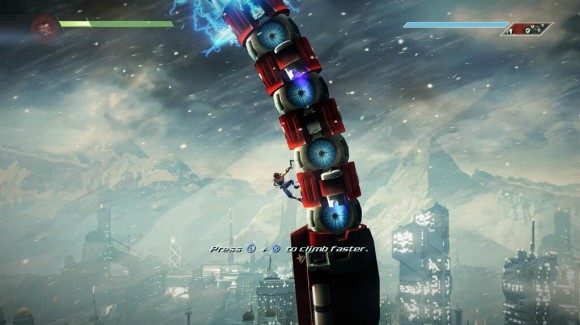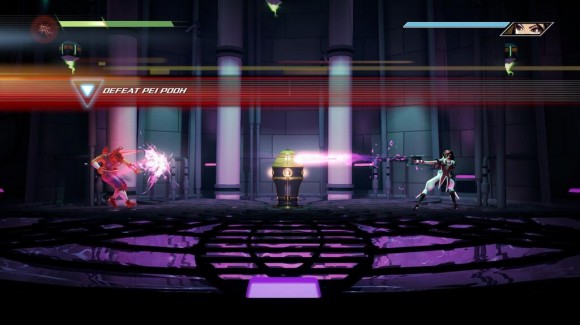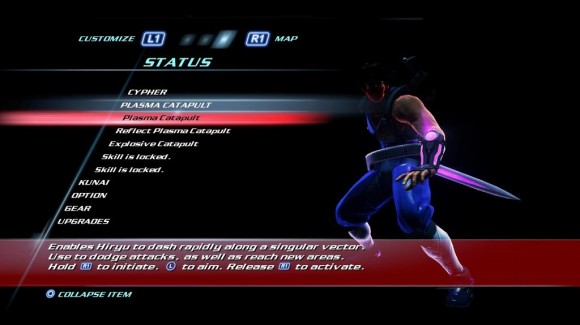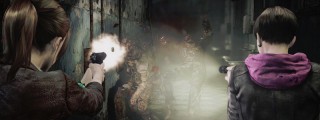Strider does not begin with much fanfare. There’s no introductory cutscene to speak of, no storyline given for you to catch up on, Strider Hiryu himself doesn’t even have a speaking line until about 50 minutes into the game. After taking a few steps past your landing zone some text pops up: “Eliminate Grandmaster Meio”. Okay, I guess I’ll do that.
This might sound like a bad thing but really it’s fairly par the course for a game in the Strider series, they’ve never really been about story, they’re about running around killing robots and girls with the last name Pooh.
Developer Double Helix’s best step in rebooting the Strider franchise has been to change the game formula. The series’ original arcade roots are indecipherable here and instead the game plays very much like a Metroid or Castlevania title (perhaps a bolder man would have combined those two names).
In true Metroid spirit you will find numerous upgrades throughout the game which will frequently grant you access to previously inaccesible parts of earlier levels. For the most part the entire world is yours to explore at your leisure. Some upgrades, such as the four belonging to your blade (or Cypher as the game calls it) are essential to pressing forward, but a lot of them are optional. Health and energy upgrades are frequently off the beaten path and there’s a hefty dose of other augmentations and abilities that you may not even find before the game’s end.
Though the game’s world is large and very well laid out there doesn’t feel like a lot of variety to it. You’ll visit places ranging from a subway station to a battle cruiser high up in the sky but despite all that I couldn’t shake my feeling that everything looked and felt the same.
Strider himself feels almost identical to how he controlled on the SNES or PSX iterations of the game, his blade swings as fast as you can push the button and cuts through his robotic enemies like butter, his trademark cartwheel jump is present, and as always he can use his fancy hooks to climb up just about any wall he deems necessary. Strider has always been vertically oriented and that mechanic lends itself nicely when it comes to making a full game map to explore.
For the most part the controls in the game feel spot on. I played on the PS4 and the DualShock lent itself nicely to my experience. Generally everything felt really solid and responsive, my one complaint would be that the game doesn’t always make great use of the analog stick. Usually while climbing I would find that if the stick wasn’t perfectly centered in the left or right side Strider just simply wouldn’t move at all. A lot of times this game asks for precision and I would have been a lot happier with the option to use the d-pad.
As I mentioned earlier, the story in Strider is wafer thin, or so it would seem. As you play you’ll frequently find unlockable character and story intel which gives you more information about the game’s world. Unfortunately it’s all classified as “extra content” and if you want to actually read any of it you’ll have to quit out of your current game session in order to do so.
You’ll encounter bosses guarding each major upgrade that you obtain. Bosses almost all require that you learn their movesets in order to dodge their attacks. Strider has no “block” button so it’s all about avoiding what they’re slinging at you and only attacking when the time is right. This means that a lot of boss encounters just feel like trial and error at first. Luckily, for the most part bosses give way with just about the perfect number of retries, there’s even a couple that you’ll probably get on your first attempt. Tying them into your upgrades feels good because it gives you a great tangible benefit when you defeat each one.
One thing that did irk me about boss fights was my opponents’ penchants for taunting me. Almost every boss has four or five lines that they will spit out at you over and over again during your fight. It’s annoying enough having the same sneers playing over and over again but to make matters even worse every time they talk (even if you’ve heard it before) a big old subtitle bar arrives to eat up the bottom sixth of your screen. That in and of itself wouldn’t be a big deal but there were at least a couple bosses where I had to really keep an eye on the floor in order to avoid their attacks and I found myself straining to peer around a subtitle I’d already read four times in the process.
 It’s not perfect, but Strider is a very good attempt at rebooting a classic. The game took me about 5 hours in total but I bet I could have added on a couple more had I gone a completionist route. For $14.99 that’s not bad. If Metroidvania games are your thing then you could certainly do worse than this. Hopefully things go well and we’ll get an even more polished Strider title in the coming years (although hopefully not 14).
It’s not perfect, but Strider is a very good attempt at rebooting a classic. The game took me about 5 hours in total but I bet I could have added on a couple more had I gone a completionist route. For $14.99 that’s not bad. If Metroidvania games are your thing then you could certainly do worse than this. Hopefully things go well and we’ll get an even more polished Strider title in the coming years (although hopefully not 14).









